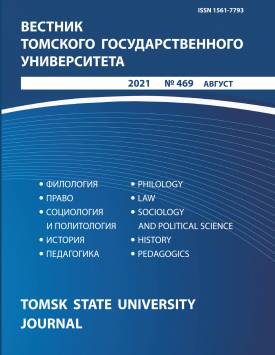The Influence of New Means of Political Communication on the Formation of a Country's Image
The image of a country has a significant impact on citizens, on their political and economic identity. The media, being an active participant in the communication process, has a large degree of influence on the image as it is formed in the minds of citizens. It is not only the media however that facilitates the formation of political views among citizens. The role of the recipient has also changed with the development of the Internet. It switched from the role of a passive participant to an active interpreter and generator of information messages. This research is aimed at studying the formation of a range of images that may internally conflict with each other. Such structures as political socialization, identity, cultural and historical connection between generations create interpretive opportunities and markers through which respondents can make their choice in regard to the information consumed. At the same time, a conflict arises between the transmitted message and the final interpretation, which emerges in the minds of citizens. The aim of this article is to theoretically substantiate the role of the communicative factor in the formation of the country's image in the minds of citizens. The article discusses the theory of perception in the context of research by E.B. Shestopal, who identified the structure of the country's image and proposed a factorial model of perception. The image of the country consists of: a spatial image, an image of a people, an image of power, and an image of a leader. The factorial model of perception consists of: objective, subjective, temporal, spatial, and communicative factors. New forms of communication create new opportunities for instant transmission of political information to citizens. All the while those channels of communication can create ranges of fictional images that will reflect the points of view of political leaders, experts, opinion leaders, chief editors, journalists, and other subjects. In addition to the variety of images, fictional “images” are formed, which means that a part of an image is replaced or completely changed. For the most part, society can be categorized into: consumers of content created and transmitted using traditional communication channels such as television, radio, newspapers, and Internet users who consume content transmitted by digital equivalents of traditional media. In this regard, the role of the recipient of the message has also changed. Citizens are no longer passive recipients of information. Instead they have become participants of the political process, which was made possible by the change in methods of communication. One of the features of new media is the ability of the Internet to generate many-to-many communication when interpersonal communication involves the one-to-one model, and mass communication the one-to-many type.
Keywords
image of country,
mass media,
communicative factor,
object-related factor,
subject-related factor,
temporal factor and spatial factor,
regional branding,
agendaAuthors
| Vinogradova Nadezda S. | Moscow State University of Technologies and Management | nadivinogradova@gmail.com |
Всего: 1
References
Власть и лидеры в восприятии российских граждан. Четверть века наблюдений (1993-2018 гг.) / отв. ред. Е.Б. Шестопал. М. : Весь мир, 2019. 656 с.
Политические коммуникации: учеб. пособие для студ. вузов / Ю.Ю. Петрунин [и др.] ; под ред. А.И. Соловьева. М. : Аспект Пресс, 2004. 332 с.
Шмелева О.Ю. «Образ государства» как категория политической науки: теоретико-методологические аспекты изучения // Политическая экспертиза: ПОЛИТЭКС. 2017. Т. 13, № 4. С. 23-36.
Гравер А.А. Образ, имидж и бренд страны: понятия и направления исследования // Вестник Томского государственного университета. Философия. Социология. Политология. 2012. № 3 (19). С. 29-45.
Брендинг территорий. Лучшие мировые практики / под ред. К. Динни ; пер. с англ. В. Сечной. М. : Манн, Иванов и Фербер, 2013. 336 с.
Анхольт С. Брендинг: дорога к мировому рынку / пер. с англ. Ю.В. Алабина. М. КУДИЦ-ОБРАЗ, 2004. 270 с.
Баженова Е.Ю. Бренд территорий: содержание, модели формирования, политика конструирования в российских регионах // TERRA ECONOMICUS. 2013. Т. 11, № 3, ч. 2. С. 120-125.
Анохин Е.В. Имидж страны: проблемы формирования и управления // Проблемы современной экономики. 2014. № 3 (51). С. 214-218.
Шестопал Е.Б. Сдвиги в массовом политическом сознании России перед Президентскими выборами 2018 г. // Вестник Томского государ ственного университета. Философия. Социология. Политология. 2018. № 41. С. 203-204.
Замятин Д.Н. Геополитика образов и структурирование метапространства // Полис. Политические исследования. 2003. № 1. С. 82-102.
Сапожникова Р.Б. Анализ понятия «идентичность»: теоретические и методологические основания // Вестник Томского государственного педагогического университета. 2005. Вып. 1 (45). С. 13-17.
Шестопал Е.Б., Зверев А.Л., Пищева Т.Н., Стрелец И.Э., Титов В.В., Евгеньева Т.В., Селезнева А.В., Виноградова Н.С., Жестков М.И., Букреева О.В., Яковлева Е.А., Палитай И.С., Затонских А.В., Гудиева К.Н., Алиференко С.Г., Башков А.В. Политико-психологические особенности электорального цикла 2011-2012 гг.: материалы круглого стола // Вестник Московского университета. Серия 12. Политические науки. 2012. № 1. С. 95-114.
Маклюэн М. Понимание медиа: внешние расширения человека. М. : Жуковский, КАНОН - Пресс - Ц, Кучково поле, 2003. 464 с.
Воронцов С.Г. Модель коммуникации Г.Д. Лассуэла как элемент методологии цивилистических исследований // Методологические проблемы цивилистических исследований. 2018. № 1. С. 414-431.
Черных А.И. Социология массовых коммуникаций : учеб. пособие. М. : Изд. дом ГУ ВШЭ, 2008. 451 с.
Дергунова Н., Завгородняя М. Теория ограниченного влияния СМК Пола Лазарсфельда как методология анализа деятельности средств массовой коммуникации // Власть. 2012. № 12. С. 13-16.
Хромова Е.Б. Поле политики в социальной философии П. Бурдье: некоторые элементы теории // Вестник Пермского национального исследовательского политехнического университета. Культура. История. Философия. Право. 2016. № 1. С. 34-43.
McCombs M., Shaw D. The agenda-setting function of Mass-Media // Public opinion quarterly.1972. Vol. 36. P. 176-187.
Manyika J. [et al.] «Big data» refers to datasets whose size is beyond the ability of typical database software tools to capture, store, manage, and analyze. McKinsey & Company : Global management consulting, 2011. URL: https://www.mckinsey.com/~/media/McKinsey/Business% 20Functions/McKinsey%20Digital/Our%20Insights/Big%20data%20The%20next%20frontier%20for%20innovation/MGI_big_data_exec_summ ary.pdf (accessed: 12.09.2020).
Черняк Л. Большие данные - новая теория и практика // Открытые системы. 2011. № 10. URL: https://www.osp.ru/os/2011/10/13010990 (дата обращения: 12.04.2020).
Crosbie V. What is new media // Digital Media Management. 2002. URL: https://digmediaman.files.wordpress.com/2011/09/what_is_new_media_by_vin_crosbie.pdf (accessed: 12.09.2020).

